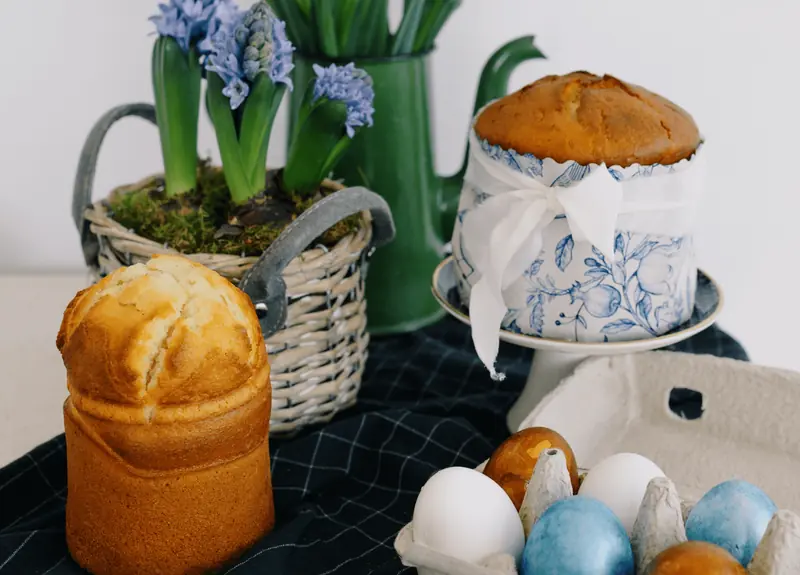
The essential components of the first Easter feast after Lent must include cheese or flour Easter cakes and decorated eggs. Let’s get to work, hostesses!
Easter Cake Recipes
Homemade ceremonial baking for Easter can consist of gingerbread, cookies, or cakes shaped like bunnies, but the preparation should start with the queen of the festive table: at least because it takes half a day to “ripen.”
The cheese Easter cake symbolizes the Tomb of Christ. It is made from rich dairy products: cheese and cream. To ensure that the conical structure maintains its shape, the cheese must be passed through a sieve. The special mold for such a cake is called a “sachnitsa.” You can substitute it with a metal strainer or grater; the holes in the dish are necessary for draining the whey.
No-Bake Cheese Easter Cake with Condensed Milk
You will need 300 g of cheese, 200 g of boiled condensed milk, 100 g each of butter and sour cream, and fillers to taste (raisins, nuts, candied fruits, orange zest); fans of fragrant spices can enhance the flavor with vanilla, cardamom, cinnamon, cloves, ginger, or nutmeg.
Before serving, this cake should sit in the refrigerator for at least 8 hours, and you won’t need to bake it.
Make sure to take the butter out of the fridge in advance to soften. Blend it with the cheese, sour cream, and condensed milk using a blender, add the fillers, and pour the mixture into a sachnitsa lined with four layers of cheesecloth. Flip the dish upside down and cover it with a weight. This is the perfect choice for those who don’t want to deal with dough and flour.
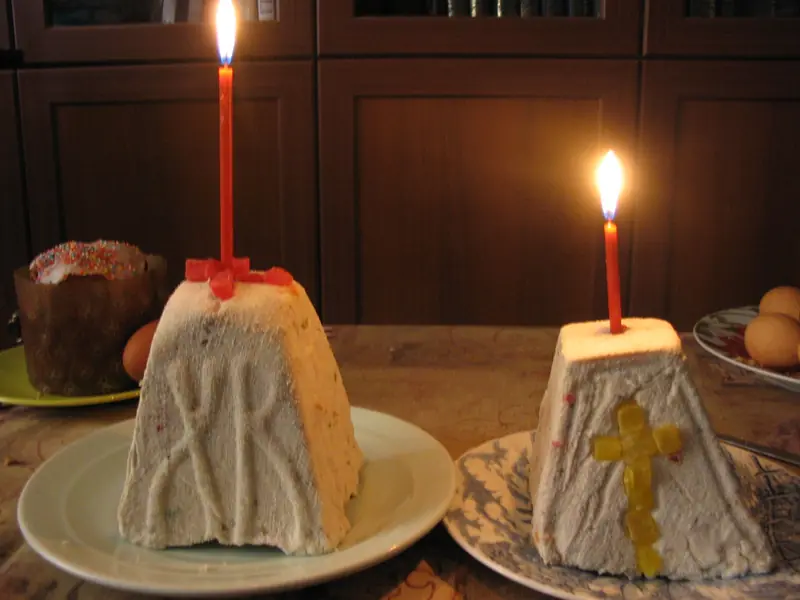
Custard Cheese Easter Cake
You will need 540 g of cheese, 100 g of cream, 100 g of soft butter, 3 egg yolks, 100 g of sugar, 10 g of vanilla sugar, and nuts or dried fruits to taste.
Using a mixer, beat the softened butter, yolks, sugar, and cheese into a homogeneous mass. Transfer the mixture to a saucepan and heat it over low heat until bubbles form (do not boil). Once removed from the heat, add the vanilla sugar, place the saucepan in cold water, and cool the cheese mixture.
Add whipped cream, nuts toasted in a dry pan, and dried fruits to the mixture. Pour the mixture into an inverted and lined sachnitsa. Press down with a weight and refrigerate for 10-12 hours, placing a bowl underneath to catch the whey. Drizzle the finished cake with melted chocolate or sprinkle with coconut flakes.
Classic Easter Cake Recipe
The hallmark of this recipe is the preparation of the sponge. The classic Easter cake is baked from yeast dough.
Ingredients: 500 g of wheat flour, 25 g of fresh yeast, 100 ml of warm milk, 200 g of sugar, 100 g each of butter and 25% sour cream, 2 eggs, 60 g of raisins, 70 g of cranberries or candied fruits, 3 tablespoons of vegetable oil, ½ teaspoon each of salt and turmeric.
Icing: 100 g of powdered sugar, ½ teaspoon each of gelatin and lemon juice.
Prepare the sponge. Dissolve the yeast in warm milk, add a spoonful of sugar, and mix. Stir in three tablespoons of flour. After mixing, let the mixture sit for 20 minutes until it reaches a sour cream consistency.
Beat the eggs, sugar, salt, and vanilla into a froth. Add the sour cream, butter, and turmeric. Mix until homogeneous, combine with the yeast mixture, and mix again.
Add the liquid ingredients to the flour and mix until the flour is fully absorbed. Transfer the dough to a floured surface and knead by hand. Drizzle with vegetable oil and continue kneading. Place the dough in an oiled bowl, cover with plastic wrap, and let it rise in a warm place until it doubles in size.
Stretch the dough into a flat shape, add the fillers (raisins, candied fruits, cranberries, dried fruits), and knead again. Divide the dough into molds and let it rise until doubled. In total, the sponge should take about 40 minutes to rise. Do not leave it in a draft.
The Easter cake is baked in an oven at 180°C. Check for doneness with a toothpick: it should come out dry.
To decorate the cakes, dissolve a packet of gelatin in 1 tablespoon of water and let it swell. Mix 1 tablespoon of sugar with 2 tablespoons of water and lemon juice. Heat over low heat, stirring until boiling, then remove from heat and use for decoration.
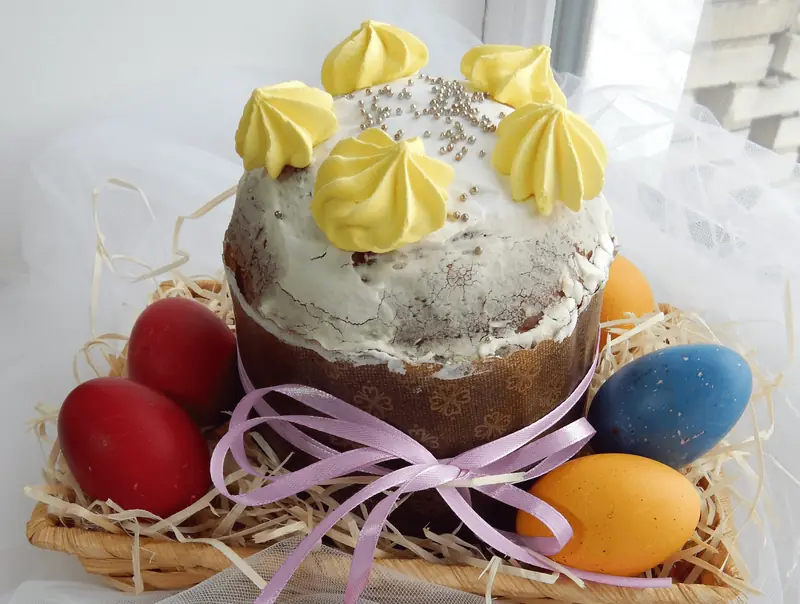
Easter Cakes with Candied Fruits
In this popular recipe, we use candied berries and fruits instead of traditional raisins. For a rich flavor, it’s important not to skimp on the fat content of dairy products: use 2.5% milk, 20% sour cream, and 82.5% butter.
Ingredients: 800 g of wheat flour, 25 g of live yeast, 220 ml of warm milk, 100 g of soft butter, 2 tablespoons each of sour cream and oil, 1 egg (only the yolk), 225 g of sugar plus 1 tablespoon for the sponge, 200 g of powdered sugar, 10 g of vanilla sugar, 1 orange (juice and zest needed), 25 ml of strong alcohol (whiskey, vodka, rum, or cognac), 100 g of candied fruits, and a pinch of salt.
For the sponge, heat 220 ml of milk (to 30°C) and dissolve the yeast and 1 tablespoon of sugar in it. Cover with plastic wrap or a towel and let it sit in a warm place for 20 minutes. When the sponge rises (it should double in size), add the egg yolk, sugar, vanilla sugar, salt, butter, and sour cream. Mix well, adding the juice of half the orange (the other half will be used for icing).
Add the flour and mix until homogeneous, optionally adding a quarter cup of strong alcohol to enhance the flavor. The cake with this ingredient acquires a delicate aroma and stays fresh longer.
Knead the dough for at least 10 minutes. When it stops sticking to your hands, form it into a ball and place it in a greased bowl. Cover and let it rise for an hour. When the dough doubles in size, reshape it into a ball. Wait another 40 minutes and add the candied fruits, ensuring they do not sit on the surface of the dough, or they will burn during baking.
Fill the molds two-thirds full. In metal molds, line the bottom with parchment paper and grease both the bottom and sides with butter. When the dough rises to the edge of the molds, place the cakes in the oven. Set the oven to convection mode and preheat to 180°C. Bake for 25 minutes and cool completely before applying the icing (a mixture of orange juice and powdered sugar). You can also add decorative sprinkles to the icing.
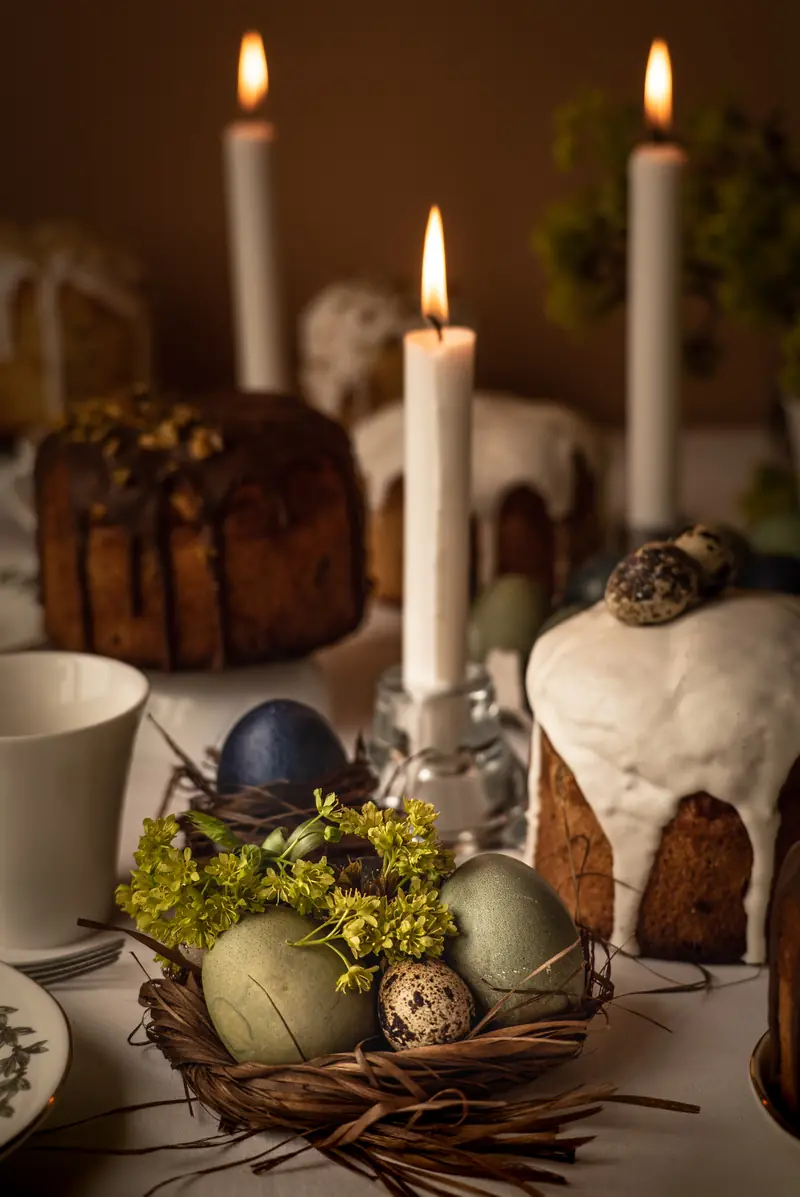
DIY Easter Cake Decorations
Typically, Easter pastries are tall, round cakes topped with white icing and colorful sprinkles. However, you can create unique decorations as well. For example, using a paper stencil cut in the shape of church domes with crosses.
Decorating with Cocoa Powder or Powdered Sugar
The cake is decorated with icing and lightly coated on top with a sticky layer of liquid honey or sweet syrup. Place the stencil over this “glue” and sprinkle cocoa powder, nut crumbs, or powdered sugar from the edges of the stencil. Remove the stencil to reveal a clear design with a distinctly outlined contour.
Glazing with Gelatin
This decoration won’t crumble because it has an elastic base.
Take 5 g of gelatin, 25 ml of water for dissolving it, 200 g of sugar, 50 ml of water for the syrup, and 1 tablespoon of lemon juice. Draw a willow branch on a white background with melted chocolate.
Soak the gelatin and let it swell (20 minutes). Cook the sugar syrup, let it cool slightly, and combine it with the gelatin and lemon juice. Whip the cream with a mixer until it reaches medium thickness: the icing should not run off or harden quickly. Once the cake is covered with a white “cap,” apply a design of willow branches using melted chocolate.
DIY Pysanky (Easter Eggs)
Decorating Easter eggs involves a dozen different techniques. The main attributes of the holiday can be painted, dyed, appliquéd, tattooed, cut out, and even embroidered. Pysanky is one of the most skilled methods of decoration, requiring certain skills, if not artistic talent. Pysankars work with raw cold eggs or blown shells, applying patterns with hot wax using a special tool. The working tool of the master is a brush or a “pysachok” – a wooden stick with a reservoir for melted wax.
After applying the first design, the egg is dipped in diluted dye: start with light colors, gradually increasing the saturation and contrast of the color. After dyeing, the item should be wiped, the next element of the pattern applied with wax, and the egg dipped in a darker dye. Once all layers have dried, the pysanka is placed in the oven (traditionally, this was done in a stove). According to the technique, the wax should completely melt and drip off the surface of the egg. Geometric patterns and natural elements are allowed in the decoration. The most popular subjects depicted on pysanky are flora and fauna.
Preparation for painting begins with making the brush (pysachok). The tool is made from thin tin or foil: roll a conical tube around a needle with a minimal (as narrow as possible) bottom opening. Secure this cone with thin copper wire to a wooden stick.
You will need:
- pysachok,
- white eggs,
- candle,
- beeswax,
- matches,
- soft pencil,
- aniline dyes for fabrics or egg dyes,
- bleach,
- vinegar,
- towel,
- napkins,
- spoon.
Dyes should be diluted in hot water (0.5 l), strained, and 2 tablespoons of vinegar added. However, if the dye is light (yellow or orange), replace the vinegar with 1 teaspoon of salt. Wash the raw eggs and dry them before painting.
While holding the egg in balance with your pinky, divide the surface with a pencil into several sections. The egg should be rotated towards you, and the line should be drawn away from you. To achieve even lines, it’s best not to change the position of the pencil in your hand. In the outlined sections, distribute the pattern of the pysanka.
Heat the pysachok in the flame of a lit candle: melt the wax, which should cover the parts of the shell that will remain white. In a spoon, dip the egg for a couple of minutes in warm, but not hot (the wax should not melt at this stage) yellow dye. After drying the dyed egg with a napkin, apply wax to the yellow parts of the ornament. Dots of green color (if present in the pattern) are applied with a match, dabbing them with a napkin and covering with wax. After this, you can dip the egg in orange dye and process it in the same manner. Next, work with red, brown, and black dyes.
To achieve a green background, first dip a red egg in clean water, then in yellow dye, and only at the end can it be immersed in green dye.
Hold the egg to the fire to melt the wax, wipe it with a cotton napkin, and rub the finished pysanka with lard for shine.
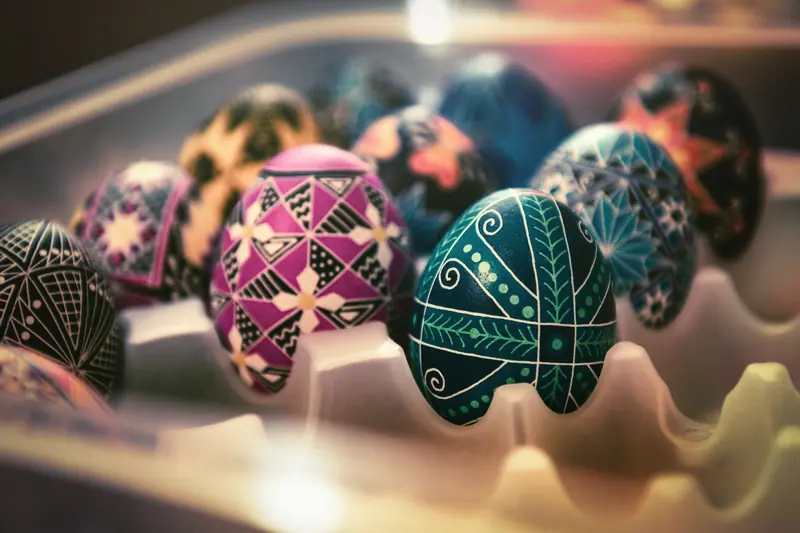
Dyed Eggs and Pysanky
The traditional technique for dyeing Easter eggs is the most accessible. If pysanky seems like “advanced level” to you, try your hand at other types of decoration. In making dyed eggs, unlike pysanky, no pysachok or wax is used. Despite the fact that the production of food dyes has been industrialized since the last century, nowadays, hostesses are increasingly returning to “grandma’s” techniques. In the old days, eggs were simply boiled in natural dyes and left in broths made from onion skins, roots, bark, buds, stems, herbs, flowers, and fruits for natural toning.
Green eggs can be achieved in a broth of nettles and spinach. Brown can be obtained from a decoction of walnut shells and partitions, black tea, or coffee. Yellow will result from boiling in turmeric. Pink eggs will be colored by cranberry broth. Blue comes from hibiscus tea. Purple can be achieved from a brew of violet petals (pour boiling water over the flowers and place boiled eggs in it overnight). For a delicate lavender tone, add lemon juice to the infusion.
For a more interesting effect, you can place herbs (parsley, dill, nettle) or leaves (from birch or oak) on the egg before dyeing. Place the egg in a stocking or wrap it in cheesecloth and tie it with thread. Once you remove the “uniform,” the pattern on the shell will pleasantly surprise you.
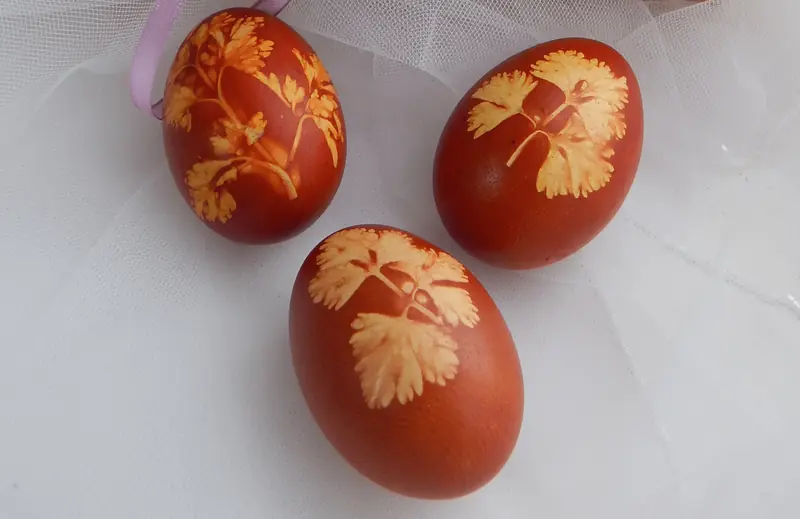
In addition to natural patterns, you can achieve interesting geometric prints on dyed eggs effortlessly: just wrap the egg with rubber bands. And speckled eggs can be made using various grains. For a more interesting effect, combine colors and techniques.
The secret to even dyeing lies in pre-degreasing the shell: first, the egg should be dipped for a minute in an acidic solution (2 tablespoons of vinegar per 1 liter of water). The intensity of the color depends on whether you placed the egg in the broth dry or wet. For a bright color, the shell should be moistened beforehand.
You can decorate the egg partially: for example, glue millet grains on one side and buckwheat on the other (or leave the opposite side of the egg untouched, keeping part of the shell in its natural state).
DIY Dyed Eggs
A bonus for those who read the Easter hacks to the end! Here we’ve gathered recipes for natural dyes.
Yellow
Eggs will turn sunny yellow in a turmeric solution. In a liter of water, dissolve 3 tablespoons of the spice, boil for 20 minutes, and then add the eggs with white shells to cook.
Pink
For a nice light purple shade, prepare a beet broth. Grate the root vegetable, cover it with 300 ml of water, and dissolve 2 tablespoons of vinegar in it. After boiling, simmer the beets on low heat for half an hour, strain the liquid into a bowl, and immerse freshly boiled eggs for 20 minutes.
Red
Pour two cups of onion skins with two liters of water and simmer for an hour over low heat. After straining, boil the eggs in the onion broth. Depending on the saturation of the broth and the time the dye interacts with the egg, you will achieve a palette of colors from red to burgundy and from golden to brick. A more saturated color will result on eggs with dark shells.
A second recipe for red tones is cherry infusion. Pour the material with water (100 g of cherry bark and branches per cup of water) and simmer for half an hour. If you leave the broth overnight, you will achieve a more saturated color. Boil the eggs in the strained infusion.
Blue and Light Blue
The broth of red cabbage is red, but eggs in it take on heavenly blue shades. Cover the chopped cabbage with 0.5 liters of water, add 5 tablespoons of vinegar, and let it sit overnight. In the morning, strain the infusion and place freshly boiled eggs in it. They should stay in the infusion for at least half an hour.
Purple and Violet
This range of tones can be achieved with frozen or fresh berries: currants, blueberries, lingonberries. Pour 200 g of berries with a liter of water, boil for a few minutes, and strain. After steeping (3-8 hours), place raw eggs in the broth and boil them (10 minutes).
Chocolate
Coffee will give eggs a brown color. Boil the eggs in a strong infusion and leave them in it for half an hour.
Once the eggs dry, rub them with sunflower oil for shine. The oil penetrates micro-cracks, acting as a sealant and extending the shelf life of the dyed eggs.
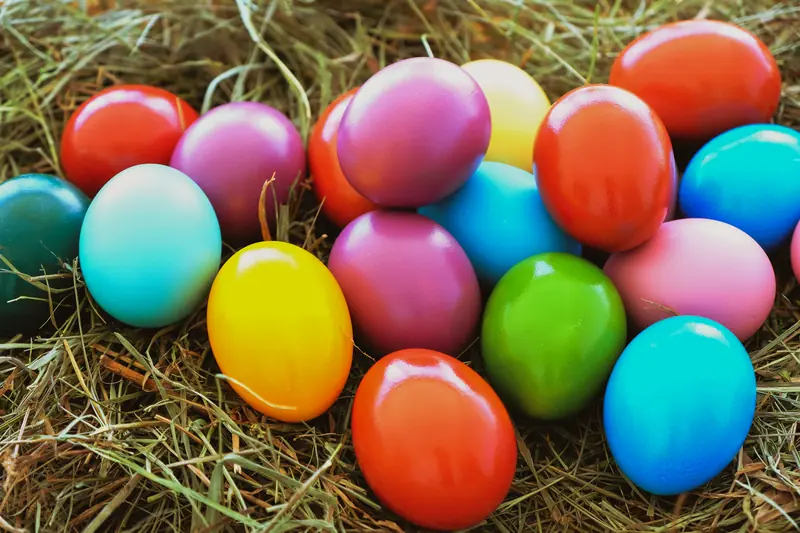
Rest assured that pysanky can also be made with “minimal effort”: you can paint eggs using a regular brush and artistic paints. Start painting from the top of the egg, then flip it over and paint the bottom. Alternatively, you can cut out details you like from colored napkins and glue them onto the egg, covering it with a clear fixative, and the picture will look just as good as if it were painted.
